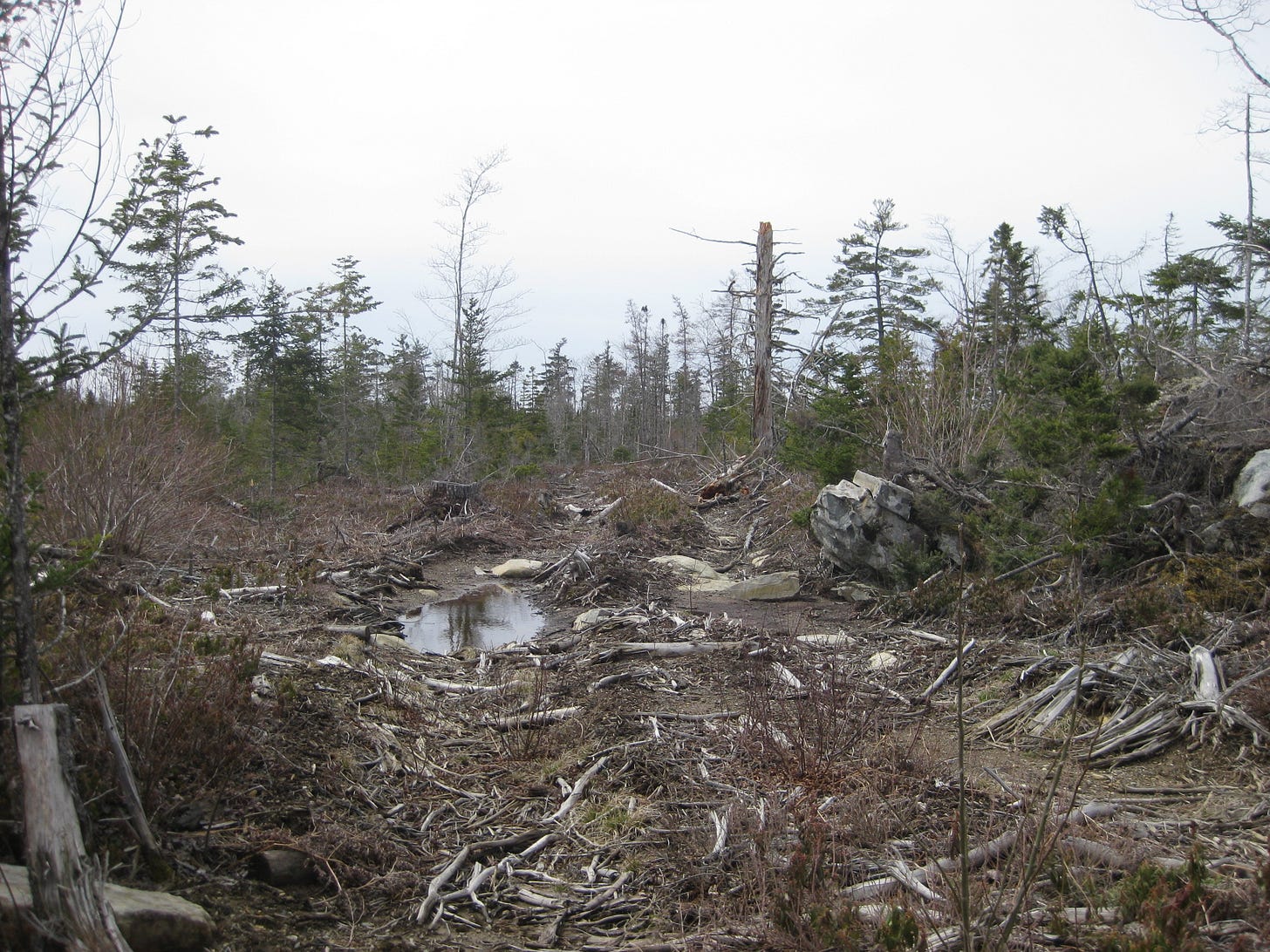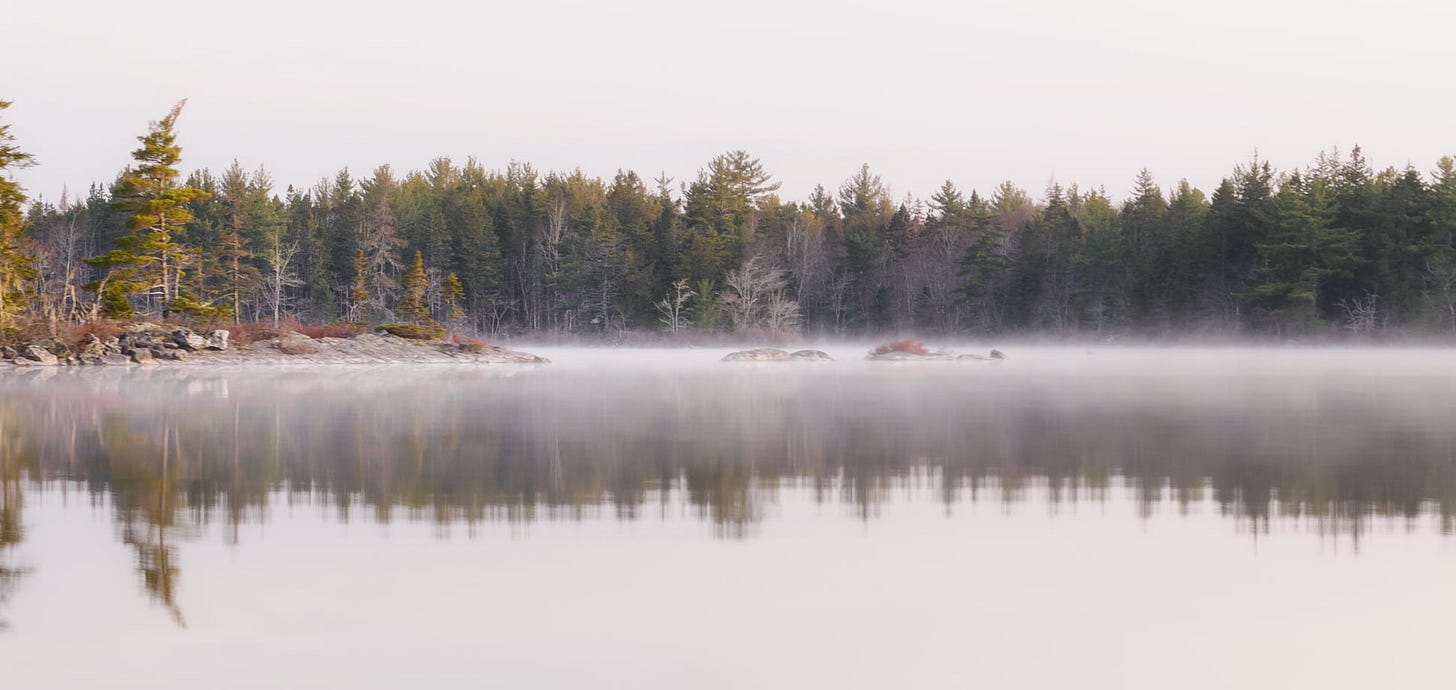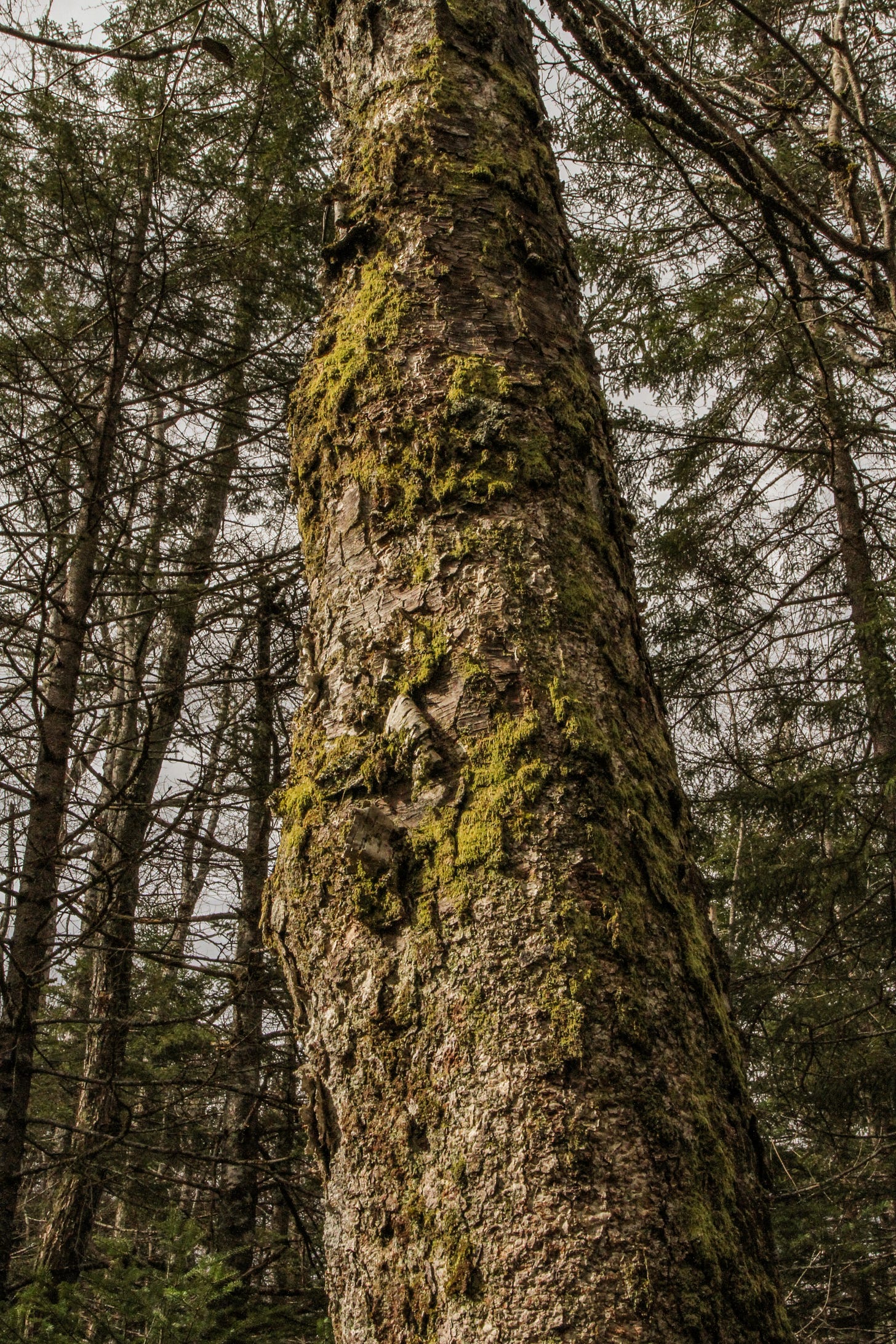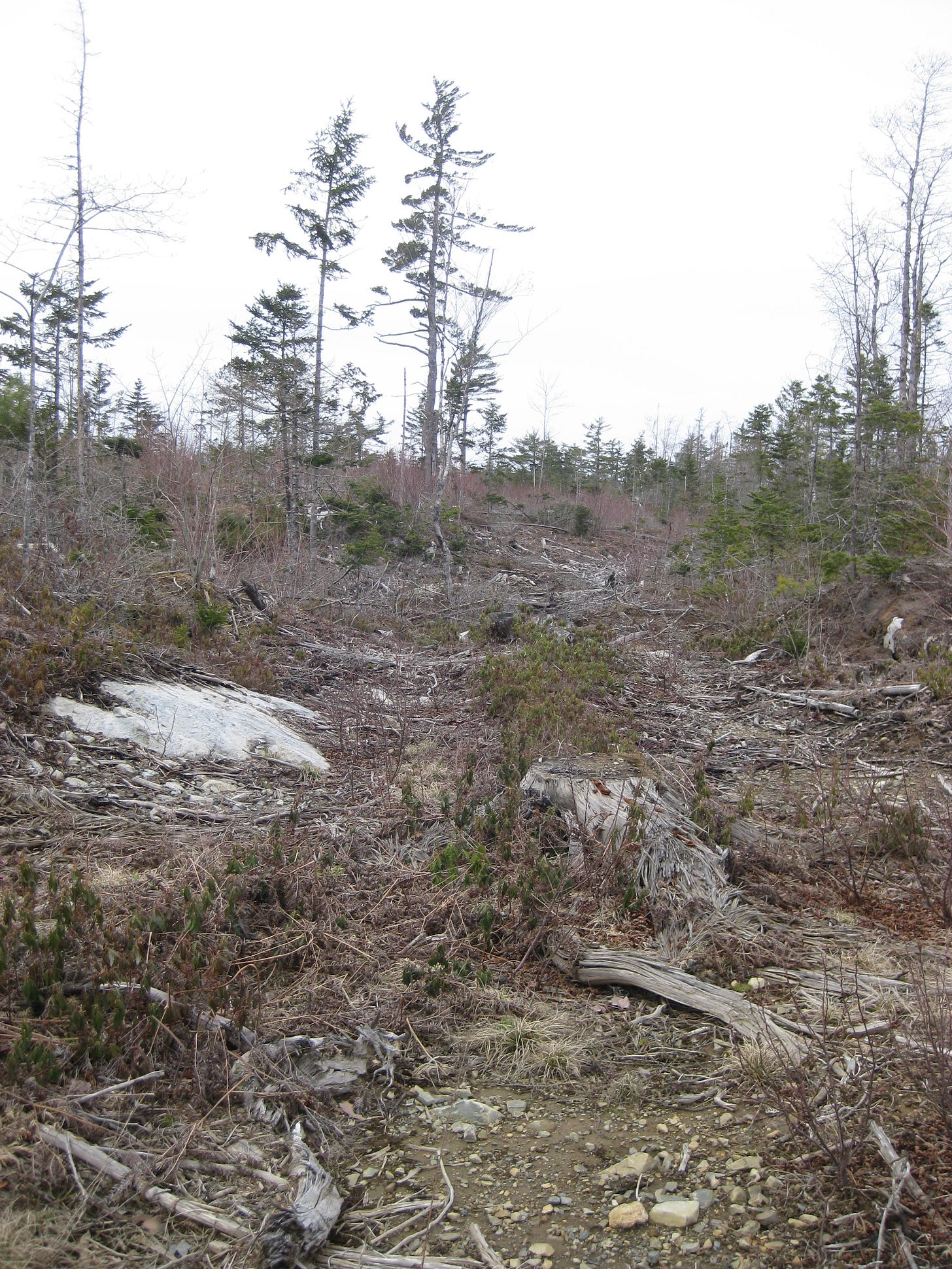The Atlantic Whitefish Whitewash
Part 3: The missing water quality science says logging has “severe implications for surface water quality" and the "effect on migratory fish may be permanent."
The slash and debris aren’t exactly what I was expecting to see within the area designated as the watershed for Bridgewater’s drinking water supply. Nor was it what I had hoped for the watershed that feeds into Minamkeak Lake, one in an interconnected system of three lakes that harbour the only surviving wild population of endangered Atlantic whitefish. But as we turn off of Lapland Rd. onto Mines Rd., the word that immediately comes to mind is wasteland. The detritus of fairly recent logging operations dominate the landscape: rutted soil strewn with overturned boulders, weathered stumps, abandoned sawlogs piled up and left to rot. As for those trees that someone decided to leave standing—(would they call these seed trees or clumps, I wonder?)—they seem to rise up out of the mangled chaos like sentinels. I’m with lichen expert, Frances Anderson, and George Buranyi, who’s heading up the Bridgewater Watershed Protection Alliance. We continue walking along the extraction road and soon enter the calm of the standing, mostly softwood, forest. Here there are bogs and swamps, meandering streams, rare mosses and lichens, and birds. The threatened, semi-aquatic Eastern ribbonsnake also calls this habitat home.
For now, anyway.
As previously reported, the Nova Scotia Department of Natural Resources and Renewables (DNRR) recently posted on the Harvest Plans Map Viewer that 103 ha (255 acres) of crown land in this watershed, including nearly 50 ha (124 acres) adjacent to Minamkeak Lake, is slated to be logged. If approved, WestFor Management will be doing the logging.
If what I’m seeing on the Mines Road is any indication of what WestFor’s practices end up looking like, we should all be deeply worried. The company’s recent logging in the watershed—a subject we’ll return to—combined with its interest in securing more crown parcels, naturally leads me to speculate about what might have happened sometime after 2006, when the first version of the Recovery Strategy for Atlantic Whitefish was penned, but before 2018, when the final version was published. At some point during this period, all the references to logging effects on water quality were either minimized or cleansed from the document.
The question is why? And did it have anything to do with the forest industry’s interest in logging the watershed?
Clearcuts along the Mines Rd. in the Petite Riviere watershed. Photo: Linda Pannozzo.
In 2016, two years before the Recovery Strategy for Atlantic whitefish was finalized, Harry Freeman and Son Ltd. clearcut two parcels of forest land that it owned bordering Mines Road, totalling 45 ha (112 acres). Shortly after doing so, the family-owned sawmill sold the clearcut land to the province.
According to the DNRR, the department acquired both parcels of land on March 29, 2016, authorized by an Order in Council (embedded below). The deal was part of much larger land transfer in which the department paid the company $3,604,216.47 million for roughly 3,240 hectares (8,010.75 acres) of land at various locations in Kings, Lunenburg, Shelburne, Queens, and Annapolis Counties. The province also had to foot the bill for any legal, appraisal, survey, and other costs, “with a grand total not to exceed $4 million,” on the condition that “all proceeds derived from the sale be paid to Nova Scotia Business Inc. to pay down debt owed by Harry Freeman and Son Limited to the Province.” An inquiry was sent to NSBI to confirm the money was used to pay down the company’s debt, but a response was not received in time for publication.*
Sometime in 2018—the same year the Recovery Strategy was finalized and published—WestFor, which includes Harry Freeman and Son—logged around the newly acquired (and already clearcut) crown parcels. It also logged other crown blocks adjacent to Lapland Rd., also within the Petite Riviere watershed.
A recent CBC news report interviewed deputy mayor Andrew Tanner, chair of Bridgewater’s Public Service Commission (PSC)—the body that operates the water utility of the town. Tanner was quoted saying that the PSC “has had issues in the past related to WestFor’s forestry practices within our watershed,” and that the logging machinery crossed waterways “causing significant siltation, waterway contamination, [and] ground disturbance.”
This certainly corroborates what I witnessed on the Mines Road.
In response to Tanner calling out WestFor for its logging practices, WestFor general manager Breck Stuart told the CBC that the company “meets the highest forestry standards in the province and is regularly audited by independent organizations.”
It is also worth noting here that Marcus Zwicker, who is currently the citizen representative on the Bridgewater Public Service Commission (PSC), is also the chief operating officer with Harry Freeman and Son, a member of WestFor’s consortium. Zwicker also held the inaugural position of general manager with WestFor during the first six years of its incorporation.
Given Zwicker’s position, and his employer’s obvious financial interest in logging within the Petite Riviere watershed, it would appear that he has a conflict of interest with regards to the operation of a water utility. Did he declare this conflict when he took on the role with the PSC? Does he recuse himself from voting or commenting about issues relating to this matter? These are questions I’ve posed to the Town of Bridgewater. I am still awaiting a response.
Google time lapse photos show Harry Freeman and Son’s clearcuts (2016) adjacent to Mines Rd. followed by WestFor’s cuts (2018). All are within the Petite Riviere watershed. The lake pictured is Minamkeak Lake.
While the DNRR has not yet granted the harvest approvals for the proposed cuts, questions remain about why the effects of logging were minimized during the Recovery Strategy’s amendment period. As previously stated in this series, the document underwent a consultation period where “additional new information was considered.” According to the DFO, the final “amended” version required consideration of “all the comments received during the public comment period on the Species at Risk Public Registry.”
Currently, it is not possible to say for certain if the changes made to the document were the result of pressure from “stakeholders” in the forest industry, but it’s certainly a plausible scenario. For instance, did WestFor and the other companies involved in the consortium, including Harry Freeman and Son, raise a ruckus with the DNRR and/ or Fisheries and Oceans (DFO) over the original version of the Recovery Strategy because they were already eyeing the crown forests in the Petite Riviere watershed? Keep in mind that Harry Freeman and Son is located in Greenfield, just 35 km from Bridgewater and since transporting roundwood isn’t cheap, the relatively short hauling distance would certainly have added to the crown land’s appeal.
Or did the DNRR, acting on behalf of vested forest industry interests, play a role in watering down the Recovery Strategy? Light will hopefully be shed on these questions when the Access to Information results come in.
Minamkeak Lake, Atlantic whitefish territory. Photo courtesy Paul Newton.
The missing water quality science surfaces
In Part 1 of this series I noted that both the 2004 DFO study on human-induced mortality of Atlantic whitefish, as well as the 2006 Recovery Strategy for the species, included detailed sections on the effects of logging on water quality. Both documents also referenced two important, unpublished studies. One was co-authored by Nancy Llewellyn for the Bridgewater PSC in 2000.[1] The second unpublished study—cited extensively by Llewellyn—was also cited in both DFO studies and appears to be ground zero for much of the forestry-related information specific to the Petite Riviere watershed. It’s the 1999 Master’s thesis by St. Mary’s University graduate student Saide Sayah titled: “A cumulative effect assessment of the Petite Riviere Watershed.”
Recall that both the forestry-related water quality impacts and the references to Llewelyn and Sayah were missing from the 2018 “amended” Recovery Strategy for Atlantic whitefish. In fact, there was little, if any, mention of forestry practices at all in the Strategy’s amended/ adopted version.
The 2000 study by Llewellyn (embedded below) was “intended to identify historical and current land use activities which may be affecting or have the potential to affect the present water quality” in the water supply area for the town of Bridgewater. It’s a fascinating read, especially the history surrounding gold mining in the watershed.
From Llewellyn’s study:
Current land use problems exist with regard to forestry practices such as clearcutting in the area of Frederick’s Brook. Recommended buffer zones to prevent erosion are not recognized and the siltation of the brook and the western end of Minamkeak Lake may be the result.
The study also noted that mineral exploration and development in the watershed should be discouraged due to the potential for contamination from heavy metals and chemicals used in the gold extraction process: “It is easier to prevent a problem such as this than to try to deal with the irreparable damage which could result. The water supply will benefit many people as a long-term resource if properly managed and mining benefits fewer people and is a much shorter-term resource.”
The same could be said for logging.
Inflow from Frederick’s Brook, Minamkeak Lake. Photo courtesy Paul Newton.
Even as far back as 2000 it was recognized that the presence of Atlantic whitefish in the watershed, combined with it also requiring safeguarding as Bridgewater’s drinking water supply, made the area a natural candidate for a “protected wilderness area.”
The study also noted that Atlantic whitefish “are sensitive to any changes in their habitat including pH, temperature, and oxygen levels.”
Most of the information relating to “current land use” in Llewellyn’s study was taken from Sayah’s 1999 thesis, which I located in the St. Mary’s University library archives. Sayah’s thesis was an attempt to determine the “cumulative impact of land uses and other human activities” on the Petite Riviere watershed. It was very specific to this geographical location, and since the Atlantic whitefish are only found in this geographical location in the wild, it’s remarkable—shocking even—that the study would be expunged from the species’ Recovery Strategy.
It's also a rather stunning deletion because the stated objective of Sayah’s thesis was to create a database for the Petite Riviere Watershed Advisory Group, “concerned with the overall health and integrity of the watershed ecosystem, with special regard for adverse effects on endangered fish species.” While this particular advisory group no longer exists, Sayah’s contribution—“to identify areas within the watershed where land uses and activities are significantly affecting surface and groundwater quality”—remains a valuable one.
Sayah’s study hinged on the understanding that incremental, “individually minor” impacts from past actions, combined with those of the present and reasonably foreseeable future, lead to cumulative impacts, which can end up being “collectively significant” over a period of time.
The hydrologic system has many vulnerable points where relatively small disturbances/ effects from land use and activities may enter and cause large changes in the functioning of the system.
According to Sayah, forestry was the most dominant land use in terms of surface area and “could become a major threat to water quality if left unregulated.”
Large companies and private wood lot owners clear the harvested areas. The impact is greater among lots cleared by private owners… There seems to be little enforcement, as many cleared wood lots overlap water bodies throughout the watershed. Such practices increase erosion and siltation of water bodies and also removal of the tree canopy adversely increase stream temperature in the summer.
Sayah lays out in no uncertain terms that clearcutting results in “erosion containing large amounts of eroded sediments, destruction of stream courses and an increase in stream temperature.” The importance of this effect is that it can “alter spawning grounds of endangered migratory fish through siltation and channel alteration,” he writes.
Sayah does note that “selection” harvests would likely result in “minimal” erosion and runoff and would also have “minor effect from the transport of trees out of the harvest site.”
But, according to the DNRR, none of the proposed cuts would be “selection” cuts, which by definition maintain high levels of continuous canopy cover as well as a diversity of tree age classes. The 78.3 hectares encompassing the area adjacent to Minamkeak Lake would be a “gap shelterwood with reserves” harvest. The remaining 25 ha is a “partial overstory removal.” There is little evidence, at this point anyway, that these new terms aren’t just industry speak for a two-stage clearcut.
As I pointed out in Part 1 of this series, when I asked the DNRR specifically about how much forest canopy would be removed (or would remain) in these “treatments,” I was pointed to the newly minted silviculture guide—which did not provide any definitive answers.
Don’t get me wrong. The development of the silviculture guide to better reflect the objectives of ecological forestry laid out in the Lahey Review is a good thing. But with little to no enforcement, the “guide” will end up being just that— a guide, open to interpretation and toothless.
Sayah also provided a map showing that the land adjacent to Minamkeak Lake (where logging is currently proposed) and between Hebb and Milipsigate lakes has “thin/ absent soil cover.” What are the chances of a forest regenerating in that landscape?
Finally, Sayah had this to say about the slash and debris that routinely blocks streams from cutting operations, affecting water quality, and carrying sediments into waterways:
Such impacts have severe implications for surface water quality and although the impacts may be temporary, the effect on migratory fish may be permanent.
Mosses and lichens cover tree adjacent to Minamkeak Lake. Photo courtesy Simon Ryder-Burbidge.
Groups call on DNRR to “reject” forestry harvests at Minamkeak Lake
Logging in Atlantic whitefish territory is also an affront to one of the “action” items in the “amended” version of the recovery strategy, which calls for “supporting the Protected Areas Branch” and exploring “the concept of establishing the public lands around Minamkeak, Milipsigate, and Hebb lakes as a provincial ‘Wilderness Area’.” The partners listed for this action item are the Recovery Team members, Nova Scotia Environment (NSE), and DFO.[2]
As well, Coastal Action, Healthy Forest Coalition, Bridgewater Watershed Protection Alliance, Canadian Parks and Wilderness Society (NS Chapter), Dalhousie University, and the Bridgewater Public Service Commission, recently got together to call on the DNRR to “reject forestry harvests at Minamkeak Lake,” and support the establishment of a wilderness area.
In a joint letter to Tory Rushton, the Minister of DNRR, they write:
These public lands are ecologically significant and contain critical habitat for species-at-risk that should not be disturbed by industrial forestry operations…Both the Recovery and Action Plans anticipate negative impacts from forestry on adjacent lands and recommend a protected area designation as a proactive conservation measure.
I ask the DNRR why it “adopted” the Recovery Strategy’s “Action Plan,” which called for exploring the creation of a Wilderness Area in the watershed, if it planned to consider proposals to log it?
Steven Stewart with DNRR replied:
In our efforts to be fair and transparent, the department applies the same process to all harvest plan proposals that are submitted. When licensed forestry companies submit proposed harvest plans, they are placed on the Harvest Plans Map Viewer for 40 days to seek public input prior to department reviews and approvals. Information received is reviewed by department resource professionals, which include foresters and biologists. The information, if relevant, may be incorporated into the approval to ensure harvest plans are appropriate and consider site-specific information not already known to the department. The HPMV comments can include identification of potential species at risk or other operational considerations. Decisions will continue to be made based on science and evidence to ensure responsible forestry practices while protecting the province’s biodiversity… The Integrated Resource Management (IRM) team considers adjacency to protected areas, wildlife habitat, municipal water supply areas and other values before a harvest approval is granted.
Logging on the Mines Road, in the Petite Riviere watershed. Is this what the forest industry means by best practices? Photo: Linda Pannozzo
If Paul Bentzen had a magic wand
In Part 1 of this series, you were introduced to Paul Bentzen, a Dalhousie University geneticist who’s been studying Atlantic whitefish and trying to save the species for many years.
Since 2018, Bentzen and his team have captured wild larval Atlantic whitefish—baby fish that have recently gained the ability to swim—and raised them, with the goal of breeding them at Dalhousie university’s Aquatron Lab, an aquatic research facility. The goal is to use their offspring to support the remaining population and to establish additional breeding populations in the wild.
“These baby fish have been captured in places where they would almost certainly otherwise have been eaten by predatory fishes, he says.
In our interview, Bentzen shares the good news that the breeding program recently resulted in the first spawning of the captive Atlantic whitefish.
“We now have eggs, as well as newly hatched and swimming larvae. It is still early days for the captive breeding project, but this is an important step. We have not yet released any of these baby whitefish into the wild. The eventual goal is not only to return the species to a more secure status, we also want re-establish the original anadromous life cycle,” he says.
When asked if he thinks the government (both federal and provincial) has done all it could in the last nearly 40 years, since the species was designated endangered, to ensure the viability of this species, he responds in the negative.
“The government has certainly not done all it could for the species over the last 40 years.”
Bentzen tells me that in early 2000s there was a captive breeding program for the species at DFO’s Mersey Biodiversity Facility in Milton and that it was shut down in 2012 and bulldozed two years later. The announcement, made by the Harper government, came as a shock to scientists and advocates for the Atlantic whitefish as there had been no plans in place to move the breeding program to another location. At the time, the government justified the closure on the grounds the facility was not needed because it had stocked Anderson Lake in Burnside with fish reared in the breeding program. But Anderson Lake did not produce a self-sustaining population. According to one news report, “some grew to sexual maturity, but did not reproduce — or if they did, the eggs did not make it. The fish starved, were eaten or died of old age.”
Paul Bentzen is a Dalhousie University geneticist who’s been studying Atlantic whitefish and trying to save the species for many years.
According to the 2006 Recovery Strategy, the captive breeding techniques developed at the Mersey Biodiversity Facility allowed the species to be spawned and reared in abundance in captivity. It was one of the reasons recovery was deemed “technically feasible.”[3]
There have been other stories about how the DFO appeared willing to abandon the species. One involved a decision to re-introduce fish being stored at the Coldbrook Biodiversity Facility back into Hebb Lake, “where they would almost certainly have ended up in the bellies of chain pickerel,” recounts Bentzen. “It was only by chance that Paul Withers at CBC found out about this before the ‘release’ took place, and he let me know about it. I immediately offered to provide a home for those captive fish at Dalhousie…and fortunately my offer was accepted.”
Bentzen clarifies that the decision to “dump the juvenile whitefish back into Hebb” was not made by DFO scientists. “It was an administrative decision made at a higher level, presumably motivated by financial considerations,” he says.
Bentzen says around the time of the Milton facility closure, chain pickerel were also being detected in the Petite Riviere watershed.
Bentzen works with a small, dedicated team of DFO biologists, who have done what they can to support the species. But he says funds are limited and there has been no long-term support promised for the species. “Such long-term support is critically needed to ensure continuity of efforts to save the species.”
The absence of a clear commitment (as yet) from the provincial government to provide the highest level of protection for the remaining habitat, by prohibiting logging around the shores of the three lakes where the species survives is also an example of failure of that level of government to do everything it can to support the species.
If Bentzen had his way, control measures for the invasive chain pickerel and smallmouth bass would continue and a sustainable, long-term captive breeding program to support reintroduction efforts would be established. “This would provide insurance for the species until it is secure in the wild,” he says. The captive fish should be kept in at least 2 locations, for security against disease outbreaks, mechanical failures, etc.
Bentzen says large numbers of the “captive-bred” juveniles should be reintroduced into the two lower Petite Riviere lakes (Hebb and Millipsigate) and below the Hebb dam to try to restore anadromy. “Minamkeak Lake should be left alone (no introductions there) because it currently has the most secure breeding population.”
Atlantic whitefish should also be introduced into other locations in the province and perhaps elsewhere in Atlantic Canada, he says. Bentzen says the locations should be “chosen carefully, with the environmental requirements of the species in mind, risk posed by aquatic invasive species, and bearing in mind climate projections for at least the next half-century.”
“This could put the species on a more secure footing,” he says. All this also depends on ongoing research and monitoring, which requires long-term, stable funding. “That requires political will, which will be closely tied to public awareness.”
* Response received from NSBI (May 4, 2022): According to Shawn Hirtle, Director of Communications and Public Affairs with Nova Scotia Business Inc., in March 2016, there was $9.9 million in principal outstanding in loans. Between then and March 2018, Harry Freeman and Son Ltd. repaid all loans in full.
[This is an ongoing series. Stay tuned for the results of the Access to Information request]
[1] Llewellyn, N., C. Mosher and N. Joseph. 2000. Historical and current land use study of the Petite Rivière watershed above Hebb Lake dam. Unpublished manuscript prepared for the Bridgewater Public Service Commission. October 2000. 45p.
[2] Fisheries and Oceans Canada. 2018. Action Plan for the Atlantic Whitefish (Coregonus huntsmani) in Canada. Species at Risk Act Action Plan Series. Fisheries and Oceans Canada, Ottawa, p. 24.
[3] 2006 Recovery Strategy, pp. 18-19.












Linda asks: What are the chances of a forest regenerating in that landscape (“thin/ absent soil cover”) ? Well, something will regenerate, but usually the next rotation is ecologically and economically inferior to the forest it replaced, and especially so if clearcutting is the harvest method used. The late Ralph Johnson, formerly the chief forester for Bowater Mersey, had this to say in his 1986 book "The Forests of Nova Scotia": ...clearcutting of extensive areas in Nova Scotia is second only to fire in being detrimental to the ecosystem, and the greater the percentage of biomass removed, the worse it is. Even where logging debris is left following clearcutting, soil fertility is reduced. ... As clearcutting continues in succeeding forest generations, the acreage thus degraded increases. " It is forest industry fantasy that our forest lands can be repeatedly harvested on ever-shorter rotations without dire consequences. The cumulative degradation caused by industrial logging cascades throughout the ecosystem, and eventually impacts the Atlantic whitefish and all living things.
Well Done Linda. What a prodigious amount of research and digging you have done to expose the machinations of our government and private corporations. All these land use/ forestry practices are being done with blatant disregard for everything but short term profit. The damage done by the Harper Conservative government with regards to shutting down scientific programs and conservation initiatives was a major setback and we are still recoiling from them. Subsequent governments have been woefully inadequate in rectifying the damage. It’s a sad state of affairs that it is left up to a few concerned unpaid, voluntary individuals and groups to protect the land that our elected, paid government officials are supposed to.